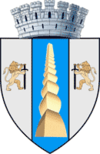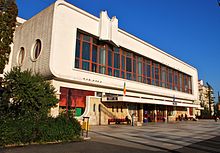- Târgu Jiu
-
Târgu Jiu — County capital — The Gate of the Kiss - Constantin Brâncuşi 
Coat of armsLocation of Târgu Jiu
Coordinates: 45°2′3″N 23°16′29″E / 45.03417°N 23.27472°ECoordinates: 45°2′3″N 23°16′29″E / 45.03417°N 23.27472°E Country  Romania
RomaniaCounty Gorj County Status County capital Government – Mayor Florin Cîrciumaru (Social Democratic Party) Area – Total 102 km2 (39.4 sq mi) Population (2002 census[1]) – Total 96,641 Time zone EET (UTC+2) – Summer (DST) EEST (UTC+3) Website http://www.targujiu.ro/ Târgu Jiu (also spelled Tîrgu Jiu; Romanian pronunciation: [ˌtɨrɡu ˈʒiw]) is the capital of Gorj County, Oltenia, Romania. It is situated on the Southern Sub-Carpathians, on the banks of the river Jiu. Eight villages are administered by the city: Bârseşti, Drăgoeni, Iezureni, Polata, Preajba Mare, Româneşti, Slobozia and Ursaţi.
Contents
History
The city takes its name from the river "Jiu", which runs through it. In antiquity, there was a Dacian village in around the location of today's city surrounded by forests. After the Roman conquests of Oltenia (101-102), military units were stationed around the roads that connected different important routes at the time. During the digging of the Târgu Jiu - Rovinari railroad, mosaics, coins, ceramics and Roman bricks were found in the south-eastern part of the city. This and ancient testimonies support the idea that Târgu Jiu was a commercial town (a vicus) while under the Roman Empire's rule. A very important route that connects the Danube to Transylvania runs through the city, so historians believe that part of the Roman Army under Trajan's leadership stayed and then passed in the actual location of the city.
After the 271 withdrawal of the Roman army, the city remained in the Latin influence zone, mainly because of Constantine The Great's involvement in Oltenia which he sought to bring under Imperial rule. The importance of keeping this zone under Rome's control was underlined by Constantine's decision to build a second bridge over the Danube between today's Corabia (then Sucidava) and the Bulgarian city of Gigen. It was over 2400 meters long, one of the longest of all time.
This territory was under Litovoi's rule, a Vlach (Romanian) voivode in the 13th century whose territory comprised northern Oltenia. He is mentioned for the first time in a diploma issued by king Béla IV of Hungary (1235–1270) on 2 July 1247. In 1277 (or between 1277 and 1280), Litovoi was at war with the Hungarians over lands king Ladislaus IV of Hungary (1272–1290) claimed for the crown, but for which Litovoi refused to pay tribute. Litovoi was killed in battle.
The first written account of the city appears in a document dating since 23-rd of November 1406 in an order signed by Mircea cel Batran. Since 1497, the city has been the seat of Gorj County.
Constantin Brâncuşi, who had lived here as a boy, was commissioned to contribute to a memorial monument to the fighters of World War I, called Calea Eroilor / The Heroes' Street and was finished in 1938. His large sculptures are now the main tourist attractions in Târgu Jiu: The Table of Silence, The Gate of the Kiss, Chairs' Alley and The Endless Column. The latter is shown in the middle section of the city's coat of arms.
In the 1950s, the Communist mayor planned to demolish Brâncuşi's "bourgeois" art. The plan was not carried out.
Starting in the 1960s, coal surface mining contributed to a rapid population growth. Other local industries include wood, machine building, textiles, glassware and construction materials (cement, bricks and tiles).
In 1992, a university was founded and named after Brâncuşi.
Coat of arms
The Coat of Arms of Târgu Jiu consists of a Shield with seven towers. In the centre of the Shield lies the representation of Constantin Brâncuşi's Endless Column, a symbol of Romanian art and culture. In the right and left sides of the shield lies a golden lion holding a black sword, "garding" the Column. The Lion is the ancient symbol of Oltenia, thought to be originating from the logo of one Rome's Legions station in this aria, the 13th Legion "Gemina(Legio XIII Gemina)". It represents the bravery and combative spirit of the city's inhabitants.
Neighbourhoods
- 9 Mai the biggest, including:
- 23 August
- Lido
- Turn
- Diana
- Minerilor
- Abator
- Alexandru Ioan Cuza
- Zona Piata Mica
- Victoriei 2
- Gară
- Victoriei
- Centru
- Unirii
- Zona Piata Mare
- Grivitei
- 1 Mai Vest
- Debarcader
- CAM
- ACH
- Meteor
- Primaverii
- Dragoieni
- Romanesti
- Luncilor
- Bicaz
- Barsesti-Slobozia
- Vadeni
- Artego
Population
- 1889: 4,076
- 1900: 6,634
- 1940: 26,634
- 2002: 96,641 (census data)
According to 2002 population census, from the total of 104.596 people : 96,79% are Romanians (93.546 people), 3,01% Gypsies or Roma people (2.916 people) and 0,20% others.
As of January 1, 2009, 95,669 inhabitants live within the city limits.[2]
Transport
- The public transport system of Târgu Jiu consists of 2 trolleybus lines and 8 bus lines. It is operated by S.C. Transloc. S.A. A ticket for one trip costs around 0.3€.
- The main railway station is situated on Nicolae Titulescu Blvd. It was built within the last 25 years.
- The city's road network consists of five boulevards (Blvd. Constantin Brancusi, Blvd. Nicolae Titulescu, Blvd. Republicii, Blvd. Ecaterina Teodoroiu, Blvd. Unirii). The main street of the city is Calea Victoriei (Street of the Victory). The largest boulevard in Târgu Jiu is Blvd. Ecaterina Teodoroiu.
- Târgu Jiu is crossed by many important roads, such as E 79 and DN 67.
Culture
Constantin Brâncuşi has three art works exposed in the city of Targu Jiu:
- The Endless Column
- The Table of Silence
- The Kiss Gate
Education
Main high schools are:
- Scholar Group Energetic Nr. 1"
- National College "Ecaterina Teodoroiu"
- National College "Tudor Vladimirescu"
- National College "Spiru Haret"
- Colegiul General "Gheorghe Magheru"
- Colegiul Comercial "Virgil Madgearu"
The universities are:
- Constantin Brâncuşi University
- Spiru Haret University
Twin cities
Sports
The main soccer team of the city is Pandurii Târgu-Jiu who owns the stadium Stadionul Municipal (Târgu Jiu). Also, the city has one team in Divizia A (Baschet Masculin) , CS Energia Rovinari and one handball team in the first division, HC Lignitul Energia Pandurii Târgu Jiu.
References
- ^ 2002 Census
- ^ "Populaţia stabilă la 1.01.2009" (in Romanian). INSSE. May 19, 2009. http://www.insse.ro/cms/rw/resource/populatia%20stabila%20la%201%20ianuarie%202009%20si%2018.xls?download=true. Retrieved September 7, 2009.
External links
 Media related to Târgu Jiu at Wikimedia Commons
Media related to Târgu Jiu at Wikimedia CommonsCounty seats of Romania (alphabetical order by county) Alba Iulia • Arad • Piteşti • Bacău • Oradea • Bistriţa • Botoşani • Braşov • Brăila • Buzău • Reşiţa • Călăraşi • Cluj-Napoca • Constanţa • Sfântu Gheorghe • Târgovişte • Craiova • Galaţi • Giurgiu • Târgu Jiu • Miercurea-Ciuc • Deva • Slobozia • Iaşi • Buftea • Baia Mare • Drobeta-Turnu Severin • Târgu Mureş • Piatra Neamţ • Slatina • Ploieşti • Satu Mare • Zalău • Sibiu • Suceava • Alexandria • Timișoara • Tulcea • Vaslui • Râmnicu Vâlcea • Focşani
Bucharest (national capital)
Cities Târgu Jiu (county seat) · Motru
Towns Bumbeşti-Jiu · Novaci · Rovinari · Târgu Cărbuneşti · Ţicleni · Tismana · Turceni
Communes Albeni · Alimpeşti · Aninoasa · Arcani · Baia de Fier · Bălăneşti · Băleşti · Bărbăteşti · Bengeşti-Ciocadia · Berleşti · Bâlteni · Bolboşi · Borăscu · Brăneşti · Bumbeşti-Piţic · Bustuchin · Câlnic · Căpreni · Cătunele · Ciuperceni · Crasna · Cruşeţ · Dănciuleşti · Dăneşti · Drăgoteşti · Drăguţeşti · Fărcăşeşti · Glogova · Godineşti · Hurezani · Ioneşti · Jupâneşti · Leleşti · Licurici · Logreşti · Mătăsari · Muşeteşti · Negomir · Padeş · Peştişani · Plopşoru · Polovragi · Prigoria · Roşia de Amaradia · Runcu · Săcelu · Samarineşti · Săuleşti · Schela · Scoarţa · Slivileşti · Stăneşti · Stejari · Stoina · Ţânţăreni · Teleşti · Turburea · Turcineşti · Urdari · Văgiuleşti · Vladimir
Categories:- Cities in Romania
- Populated places in Gorj County
- Târgu Jiu
Wikimedia Foundation. 2010.


